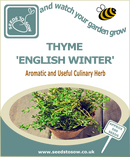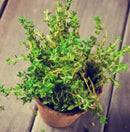Description
The English Winter Thyme is a low growing, hardy perennial with woody stems and small, oval dark green leaves. The small leaves have a powerful aromatic flavour and are an important ingredient in Bouquet Garni and Herbes de Provence.
The pale mauve-pink flowers are extremely attractive to bees and butterflies, making thyme a useful addition to any garden whether in a herb garden, as an edging plant on a mixed border, in a rock garden or in a hanging basket.
| When to Sow | Sow indoors March to early May and outdoors late May, August and September. |
| Where to Sow | Prefers well-drained soil and a sunny position. |
| Sow indoors, thinly in pots or trays, onto moist well-drained seed compost and cover with a little soil. | |
| Sow outdoors, once the soil has warmed, thinly onto the surface of a well prepared bed, with rows 30cm (12in) apart. | |
| Mixing the seed with horticultural sand may make it easier to sow thinly. | |
| Keep the soil moist, but not wet and germination should occur in about 15 days. | |
| What to do Next | When seedlings are about 5cm (2in) tall, transplant outside after hardening off for 7 to 10 days. |
| Place in either a pot or container or direct into the garden, with 15cm (6in) between each plant and 30cm (12in) between rows. | |
| Keep watered in dry spells and weed free. | |
| Place a collar of horticultural grit or gravel around plants in the ground to protect the foliage from rotting in wet soil. | |
| Harvest | June to September in first year, all year round once established. |
| Handy Tips | Harvest sparingly in the first year to allow the plant to establish itself. |
| Pinch out the growing tip of small plants to encourage a bushier plant. | |
| Companion Planting | Cabbages, cauliflowers, brussels sprouts and other brassicas as thyme deters the cabbage root fly. |
| Nutritional Information | A good source of Vitamins A, C & K. |
| Serving Suggestion | Thyme leaves and stems are indispensable in flavouring soups, stews, sauces, stuffing or in beef, pork, lamb or chicken dishes. Thyme is best known as one of the primary components in a classic bouquet garni and in Herbes de Provence. |
Payment & Security
Your payment information is processed securely. We do not store credit card details nor have access to your credit card information.






